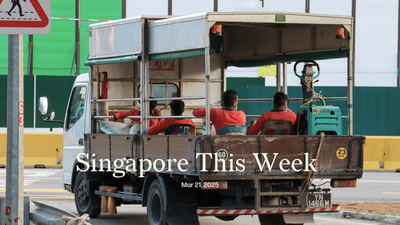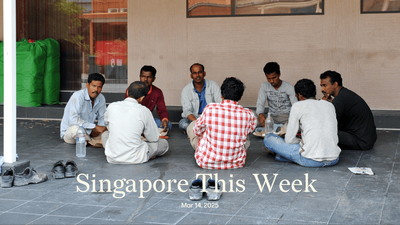Society: Multi-level marketing, capitalism’s Garden of Eden
You’ve probably experienced it. A loved one wants you to try a “special” product unavailable in stores—like a conditioner made just for your hair or deer placenta for your diabetes—and also wants you to buy more and sell it to others you’re close to. Those who’ve succeeded, they assure you, are now millionaires. You listen patiently, because it’s hard to tell if it’s a legitimate sales incentive or a fraudulent pyramid scheme. Last week, we learned a bit more about their dangers in Singapore. Mohamad Hisham Mohd Idris was sentenced to four months’ jail and a S$10,000 fine for his role in the Galaxy Trio pyramid scheme from 2013 to 2015. Hisham and Nurnavi Janti Imam Makruf, his wife, were the first Singaporeans to join this regional scheme started by a foreign firm. Its only discernible products seem to be e-books and audio tracks accessed via a website, alongside the scheme’s dubious “training and presentations”. Hisham and Nurnavi eventually recruited, directly or indirectly, 3,966 others, who channelled at least S$3.3m into the pyramid scheme. Though Hisham received about S$1.3m in cash, he paid about S$1.27m back to the firm, for a profit of just S$27,509 over the entire period (which the court ordered him to pay as penalty). Singapore’s Multi-Level Marketing and Pyramid Selling (Prohibition) Act was passed in 1973 and amended in 2000 to exclude legitimate activities, such as insurance firms and direct sellers that fulfil certain criteria, like not requiring upfront payments from participants. “MLM [multi-level marketing] schemes are in fact prohibited,” CNA explained on their legality, but followed it with the claim that “[n]ot all MLM techniques are undesirable, the Ministry of Trade and Industry said.” It may be too much to expect Singaporeans to parse these fine differences when approached by predatory firms. Which is a legal MLM and which is a pyramid? In calling for a much longer jail term the prosecution dubbed Hisham and Nurnavi the “Adam and Eve” of the scheme. The religious allusion is appropriate given that Amway, the American grand-daddy of direct sellers, which booked almost US$8.1bn (S$10.9bn) in revenue in 2023, has been criticised for selling “...a marketing and motivational system, a cause, a way of life, in a fervid emotional atmosphere of rallies and political religious revivalism.” Studies show that over 99 percent of participants in Amway-type schemes lose money. By exploiting trust in human relationships, multi-level marketing is one of capitalism’s most corrosive ideas. It’s not Adam and Eve we should be going after; it’s the Creator.
Related: “Lu La Rich”, a documentary about LuLaRoe, an American MLM company that hawked leggings but was eventually exposed as a scam. The New Yorker says it’s “...full of hard truths about the ways in which capitalism preys on struggling mothers and leads them into debt with the allure of providing for their families.”
Society: Singaporean women like their eggs frozen
After the upper age limit for elective egg freezing was raised from 35 to 37 years old last July, more Singaporean women have been undergoing the procedure as a means to preserve their fertility. Monash IVF Singapore, for instance, has experienced a 50 percent uptick in enquiries about the procedure while Thomson Medical Centre alone has conducted over 70 of them in the past five months—mostly for single women in their mid-30s. Despite a hefty price tag of S$10,000 (excluding a yearly egg storage fee) and the pain of undergoing injections almost every day for two weeks, Singaporean women are engaging in what doctors call “social egg freezing”: freezing their eggs to keep alive the possibility of starting a family later in life. (Something traditionally done before chemotherapy or late stages of endometriosis, which can reduce a person’s fertility.) “I think it is very empowering for younger women to have an option to think about fertility at a much later time. It is like buying an insurance policy,” Dr Anupriya Agarwal, from the Mount Elizabeth Fertility Centre, told CNA. Global demand for social egg freezing has been spurred partly by celebrities like Chrissy Teigen, Paris Hilton and the Kardashians, who’ve normalised and demystified the process by openly talking about their egg-freezing stories (even the ugly parts). According to TIME, the psychological effects of egg-freezing are significant: women feel a sense of control over their lives and bodies, free from the stress of a ceaseless biological clock. But just how effective is this “insurance policy”? At every step of the process—extraction, freezing, thawing, transferring—eggs are lost; each only has an estimated 2-12 percent chance of resulting in a live birth. Twenty eggs don’t equate to 20 future babies, so marketing egg-freezing as a sure-deal, as ones in the US do, may give women false hope. “As an insurance policy goes, it’s not a great one,” New York University’s Dr James A Grifo, who specialises in reproductive endocrinology, told Time. “When your house burns down, you get a new house, you don’t get 40 percent of a new house.” Hence, it’s vital that women who elect to undergo egg freezing enter the process informed, educated and with realistic expectations.
Society: MOH to review HIV disclosure law
Must people living with the human immunodeficiency virus (HIV) inform their sexual partners of the risk of contracting it from them? Yes, according to current law, which also requires them to seek their partners’ voluntary consent to accept the risk. But the Ministry of Health (MOH) is now reviewing this requirement. MOH said that it would consider the latest scientific evidence in its review of the Infectious Diseases Act (IDA) to ensure that it remained relevant and aligned with public health policy goals. “Studies show that people living with HIV who have been compliant with treatment and have maintained a stable, undetectable viral load have practically no risk of transmitting HIV to their sexual partners,” the ministry explained. MOH also noted that the law offers “choice and protection” to the partner, who can then decide whether to engage in sexual activity, and take the necessary precautions if they choose to do so. In 2008, amendments to Singapore’s IDA increased penalties for non-disclosure from a fine not exceeding S$10,000 to S$50,000 and/or a maximum jail term from two to 10 years. The possibility that the government could decide to remove the legally mandated disclosure of one’s HIV status might come as a relief to rights advocates and medical experts. Many think that the requirement is outdated, given efficacy advances in treatment; that the existing law acts as a disincentive to testing, encouraging instead a “don’t know, don’t tell” mindset; that disclosing one’s HIV status exposes the person to stigma and discrimination without due legal protection from, for instance, discriminatory employment practices; and that sexual health is a shared responsibility between partners, regardless of HIV status. Dr Rayner Tan, president of Project X, a sex worker NGO, has argued that there are reasons to believe that disclosure laws aren’t favourable for HIV prevention, noting also that many HIV-specific laws in the Western Pacific region go against UNAIDS policy recommendations. UNAIDS has advised against the broad use of the law to criminalise HIV, limiting punishment instead to rare cases of intentional and proven HIV transmission with malicious intent, i.e. “where a person knows…[their] HIV positive status, acts with the intention to transmit HIV, and does in fact transmit it.”
History weekly by Faris Joraimi
As I wrote this, some heavy afternoon rain showered the streets of Pasir Ris. While the turn of the calendar year places us in measurable time—linking our present to a countable past and future—weather events also mark time in deeper and older ways. December to early January is the ‘wet’ phase of the north-east monsoon, one of Singapore’s two monsoon seasons, with inter-monsoonal periods between them. They connect us to environmental processes happening far away. During the north-east monsoon, which coincides with winter in the northern hemisphere, the air in lowland India and South-east Asia is warmer than that of Central Asia and the Arctic. Winds form in those cold and arid regions, travelling vast distances and gathering moisture over the South China Sea before reaching us, bringing major rainfall in their wake. The monsoons profoundly shaped the history of South-east Asia for centuries, as people relied upon these seasonal patterns to organise their economic and cultural activities. An entire trading system developed from the natural wind power that carried merchant ships from Africa, Persia, and Arabia to India and South-east Asia during the middle of the year (summer in the northern hemisphere), and back the other way later in the year (summer in the southern). The north-east monsoon still affects life across Malaya: flash floods across Kelantan and Terengganu; more sailboats off Changi. As any reader of Amitav Ghosh’s novels would know, those connections between rich ports and ocean kingdoms still linger today, in familiar spicy aromas and shared loanwords. The word “monsoon” itself comes from the Arabic mausim, from which the Malay word musim is also derived: both of which mean “season”. There are dozens of Malay names for up to seven distinct musim. The one we’re in now is musim utara: the “northern season”, referring to the prevailing northerly winds. The monsoons made the Malay world, bringing different peoples and languages, and of course Islam, to its shores. They were so central to our ancestors’ understanding of geography, that this region was called bawah angin—[the lands] beneath the wind—in many old Malay tales. The wind rustling through the palm leaves, and the storm raging outside, place us in relation to this history.
Arts: Singapore Palestine Film Festival at The Projector
A farmer acquires a video camera to record the birth of his youngest son—but ends up documenting the grassroots resistance to the construction of the Israeli West Bank Barrier in his tiny village of Bil’in. Another father must reunite with his estranged son to hand-deliver his daughter’s wedding invitations just before Christmas in Nazareth. These award-winning films (“5 Broken Cameras” and “Wajib”) are part of a slate of five features and five shorts that will be screened at a film festival centering Palestinian stories. The Singapore Palestine Film Festival will run at The Projector’s new space at Cineleisure from January 12th. Its organisers hope to “shed light on the challenges faced by the people of Palestine”, with proceeds going to the Singapore Red Cross in support of civilians in Gaza impacted by the ongoing conflict. Since Hamas’ October 7th attack on Israel, at least 20,000 have been killed in Gaza (roughly one percent of the 2.2m people there) according to the local health ministry. The “indiscriminateness of the killing” is what sets the staggering death toll apart, according to economics professor Michael Spagat, who specialises in the measurement of war deaths. The festival also coincides with the ninth anniversary of the beloved indie cinema and community space. In Jom’s inaugural print issue, a profile of the Projector’s general manager Prashant Somosundram reflects how its management has consistently been attentive to soci—political urgencies and causes, and how these intersect with film as both an artistic and activist form.
Arts: Two works-in-progress at 136 Goethe Lab
Walk past the Goethe Institut on the corner of Neil Road and it’s likely you’ll hear music or sound filtering out of its slatted windows. Passers-by often squat down to peer into the German cultural association’s basement, which has been transformed from a library into a clean, spare industrial space for Singaporean artists to experiment with open studio formats and work-in-progress presentations. 136 Goethe Lab has played host to an eclectic range of artforms, from dance to community-based participatory projects. This weekend, Rosemainy Buang—a gamelan musician, composer, sound artist and educator—will continue her experiments in gamelan with a new iteration of “BANTEN”, in which she’s been exploring and extending both the conceptual and performative boundaries of the classical music medium. Rosemainy’s musical expeditions are often interdisciplinary and immersive. In “Sonic Rituals” (2022), she collaborated with several other multi-hyphenate artists to transform the Esplanade’s Annexe Studio into a series of dark and wilfully claustrophobic domestic spaces, each sculpted by sound over binaural headphones. Audience members were eventually funnelled into the relief of a light-filled open-air corridor, where Rosemainy performed live with electronic sound artist Syafiq Halid (together, they make up the electronic duo ANTARMUKA). BANTEN is also an interactive musical installation, and visitors are encouraged to roam around the lab space. The following weekend, a group of performers who identify as trans will present an in-process version of “TRANS:MISSION”, a devised documentary theatre piece. The work explores the intergenerational production of trans histories in Singapore through a series of conversations around specific keywords, including “transphobia”, “dysphoria” and “utopia”. The group hopes to deepen discourse around gender and sexuality, and create a reflective—rather than a reactive—space for the Singaporean public to understand trans issues. Performance requires presence, and the initial audiences for these two pieces will help to shape the trajectories of their development by virtue of their being there.
Tech: Stronger Japanese control over Singlife
Sumitomo Life’s impending acquisition of Singlife, a Singapore-based insurtech start-up, marks a significant consolidation in South-east Asia’s insurance sector. The deal, valued at S$4.6bn, not only positions the combined entity as a predominant insurer in Singapore, but reflects the strategic importance of South-east Asia in global insurance. It can also be seen as part of a broader trend of Japanese firms seeking growth outside their domestically saturated markets. Sumitomo Life has progressively increased its stake in Singlife since an initial investment in 2019, buying Aviva’s 25.9 percent stake and then TPG’s 35 percent stake late last year. This strategic ramp-up is reflective of Sumitomo Life’s aggressive expansion strategy into the region, Singapore’s potential to serve as an insurance hub in South-east Asia, and Singlife’s market position. The deal’s large value also underscores the confidence in the continued expansion of the insurance industry in South-east Asia, buoyed by a growing middle class and heightened awareness of financial planning needs. For Singlife, this acquisition means greater access to capital and integration into Sumitomo’s wider strategic plans for the region. Singlife has over S$14.4bn in total assets, making it one of the largest insurers in Singapore. While the company will retain its name, brand, management team and product offerings, regional consumers can expect a wider choice of financial planning solutions. Singlife’s acquisition might be the first of many in the coming months, as analysts expect a wave of merger and acquisition activity in Hong Kong and Singapore’s insurance sectors, especially for larger firms with over S$134bn assets under management.
Tech: More debt options for MSMEs in Malaysia
Funding Societies’ latest funding round from Khazanah Nasional and CGC Digital comes at an important time as the Singapore-headquartered digital lending platform looks to expand its operations in Malaysia. Khazanah’s investment aligns with its Dana Impak mandate of backing Malaysian companies delivering social and economic impact. Funding Societies has operations across five high-growth South-east Asian markets, serving nearly 100,000 businesses with over US$3.2bn (S$4.3bn) in loans. The investment will provide small businesses access to much-needed financing, and help Funding Societies achieve its goal of serving over 25,000 micro, small and medium-sized enterprises (MSME) across Malaysia by 2025. The additional capital also comes amidst rising challenges for Funding Societies. While it reported strong revenue growth of 84 percent from 2021 to 2022, losses also increased substantially by 138 percent in the same period due to non-cash expenses. Rising interest rates impacted both its cost of funds and borrowers’ ability to repay loans. Consequently, write-offs and impairment charges surged. Substantial one-off costs in 2022 included strategic investments in Indonesia’s Bank Index, the CardUp acquisition, and an ESOP (employee stock ownership plan) buyback programme. This fundraise boosts Funding Societies’ financial position as it navigates current macroeconomic headwinds and carefully manages risks to achieve profitability by late 2024. It should also aid expansion beyond key Malaysian cities while growing its new Islamic financing offerings, having already disbursed over US$21.5m (S$29.5m) within six months from launch last May.
If you enjoy Jom’s work, do get a paid subscription today to support independent journalism in Singapore.







